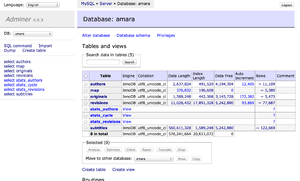Adminer
Adminer (formerly known as phpMinAdmin) is a tool for managing content in MySQL databases (since version 2 also in PostgreSQL, MS SQL, SQLite and Oracle databases). Adminer is distributed under Apache license (or GPL v2) in a form of a single PHP file (around 470 KiB in size). Its author is Jakub Vrána who started to develop this tool as a light-weight alternative to phpMyAdmin, in July 2007. Adminer got some attention in 2008 when it made it to the CCA finals at SourceForge.[2] Also, first webhosting providers started to include Adminer as MySQL managing tool into their portfolio of services. In 2012 Adminer got coverage on Linux.com for the second time.[3] The project's priorities, according to its author, are (in this order): safety, user-friendliness, performance, functionality, and size.[4]
 Adminer main screen | |
| Developer(s) | Jakub Vrána |
|---|---|
| Initial release | 25 July 2007 |
| Stable release | |
| Repository | |
| Written in | PHP |
| Available in | 42 languages |
| Type | Database management system |
| License | Apache license or GPL v2 |
| Website | www |
Features
- Users log in specifying the destination server and providing the user name and password (which is stored during whole session)
- Basic functions: select database, select/edit tables, browse/insert/edit table rows
- Searching or sorting via multiple columns
- Editing of other database objects: views, triggers, events, stored procedures, processes, mysql variables, user permissions
- Text area for arbitrary SQL commands and storing these commands in command history
- Export of databases and tables (its structures and/or data) as a dump to output or a downloadable attachment
- User-friendly interface (extensive employment of JavaScript)
- Multiple language support (Arabic, Bengali, Catalan, Chinese, Czech, Dutch, English, Estonian, French, German, Greek, Hungarian, Italian, Indonesian, Japanese, Korean, Lithuanian, Persian, Polish, Portuguese, Romanian, Russian, Serbian, Slovak, Slovenian, Spanish, Tamil, Thai, Turkish, Ukrainian, Vietnamese)[5]
- SQL syntax highlighting
- Visual database/E-R schema editing
- Countermeasures against XSS, CSRF, SQL injection, session-stealing, ...
- "Light-weight" – released in a form of a single file
- Support of CSS "skins", as well as many extensions
The small single file is a result of compilation and minification of source codes.[6]
See also
References
- "Database management in a single PHP file". adminer.org. Retrieved 2020-04-29.
- 2008 CCA: Finalists
- Manage Your Database with Adminer
- https://www.zdrojak.cz/clanky/phpmyadmin-vs-adminer/nazory/6737/
- "Adminer". SourceForge. Retrieved 2016-06-15.
- Vrána, Jakub (August 2009), "Architecture of Adminer", php-architect, 8 (8): 34–40